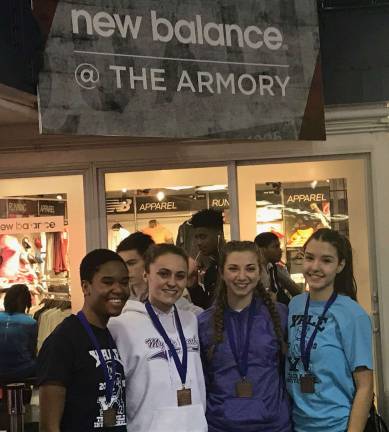Indoor track: A circus of odd events



By Patrick Brown
Walking into an Indoor Track Meet at the Ocean Breeze Athletic Complex in Staten Island is a startling experience:
Outside the building one is mostly aware of the cold wind coming off the ocean and seagulls screaming overhead.
Entering the arena is a sensory assault of sound, motion, and color.
The organization of the meet is literally a circus. Athletes from more than high schools are packed into bleacher seats.
The sharp crack of a pistol causes a platoon of runners to stampede down the track while the next section of runners is immediately herded into starting position.
On the far side, pole vaulters sprint down the runway, swing themselves upward into a handstand, contort over the bar, and seem to pause for a moment before floating face-up into the pit.
On the near side, triple jumpers execute a series of leaps and bounds that carry them across a distance as long as a house.
In the center of the track 90 athletes are queued in six lines to run 55 meter hurdles.
A starter fires his pistol every 15 seconds sending runners clattering over the hurdles, while attendants push the next set of athletes into starting position and other staff immediately realign the hurdles for the next race.
In rare instants of quiet, you can hear throwers grunting and the thump of heavy metal hitting the floor.
'How did this start?'After watching the actions for awhile a question comes to mind: “How did this start? Where did all these odd events originate?”
The first written records of the ancient Olympic Games date to 776 B.C., when a cook named Coroebus won the only event – a 192-meter footrace called the stade (the origin of the modern “stadium”) – to become the first Olympic champion.
After 13 Olympiads, two more races joined the stade as Olympic events: one roughly equal to today’s 400-meter race, and a longer-distance race, possibly comparable to the 1,500-meter or 5,000-meter event.
The pentathlon, consisting of five events - a foot race, a long jump, discus and javelin throws and a wrestling match - was introduced in 708 B.C.
Pole vaulting, in its non-competitive form, has existed since the days of the ancient Greeks, when it was used to surmount obstacles such as enemy walls or to vault over or onto animals such as bulls and horses. Poles were used as a practical means of vaulting over natural obstacles in marshy places in the Netherlands and in Britain.
Historical sources on the ancient Olympic Games occasionally mention jumps of 15 meters or more. This led sports historians to conclude that these must have been a series of jumps, thus providing the basis for the triple jump.
However, there is no evidence for the triple jump being included in the ancient Olympic Games, and it is possible that the extraordinary distances are artistic license by the authors of victory poems.
The first events resembling the modern shot put likely occurred in the Middle Ages when soldiers held competitions in which they hurled cannonballs. Shot put competitions were first recorded in early 19th century Scotland and were a part of the British Amateur Championships beginning in 1866.
The relay race originated with runners carrying messages. In some cases, messages had to be conveyed over long distances and multiple runners handed, or relayed, the message from runner to runner.
Patrick Brown is an Assistant Indoor Track Coach at Monroe-Woodbury High School.